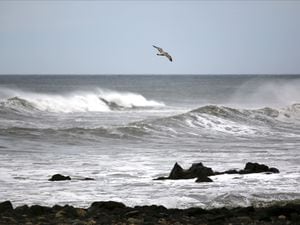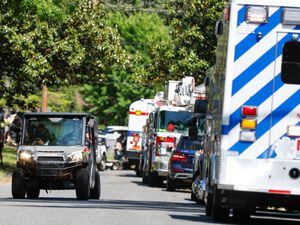Storm Lee makes landfall in Canada with winds of 70mph
The storm brought high winds, rough surf and torrential rain on Saturday to a large swathe of New England and maritime Canada.

The centre of post-tropical cyclone Lee has made landfall in Nova Scotia, Canada, with sustained winds of 70mph, US weather officials said.
The storm’s centre came ashore about 135 miles west of Halifax, Nova Scotia, the US National Hurricane Centre said. That is about 50 miles south-east of Eastport, Maine.
Once a hurricane and still almost as strong as one, Lee brought high winds, rough surf and torrential rain on Saturday to a large swathe of New England and maritime Canada, toppling trees, swamping coastlines and cutting power to tens of thousands.
Many shrugged off Lee, now a post-tropical cyclone, as not much worse than the region’s famous and frequent nor’easters, a similarity some meteorologists acknowledged even while warning people not to underestimate it.

The storm ‘s centre made landfall in Canada at near hurricane strength on Saturday afternoon, then was expected to weaken as it moved into New Brunswick and the Gulf of St Lawrence, forecasters said.
In the United States, a tropical storm warning was in effect for a 230-mile stretch from Portsmouth, New Hampshire, to the eastern end of Maine.
That included Bar Harbour, the touristy gateway to Acadia National Park, where officials closed a car park at a pier as high tide moved in and waves crashed against seawalls.
Lee flooded coastal roads and boats in Nova Scotia, knocked down power lines and trees, and took ferries out of service as it fanned anxiety in a region still reeling from wildfires and severe flooding this summer.
Nova Scotia’s largest airport, Halifax Stanfield International, had no incoming or outgoing flights scheduled on Saturday.
“People are exhausted… It’s so much in such a small time period,” said Pam Lovelace, a councillor in Halifax, the capital. “From a mental health perspective, we’re asking people to check in on their neighbours.”

A tropical storm warning was in effect for much of New Brunswick and all of Nova Scotia and Prince Edward Island, along with a hurricane watch for parts of New Brunswick and Nova Scotia.
The storm’s centre was just off southern Nova Scotia – dozens of miles south-east of Eastport, Maine — with maximum sustained winds near 70 mph, the US National Hurricane Centre said in its advisory. Hurricane strength is 74mph.
Hurricane-force winds extended as far as 140 miles from Lee’s centre, with tropical-storm-force winds extending as far as 390 miles — enough to cover all of Maine and much of maritime Canada.
The storm was so big that it caused power outages several hundred miles from its centre. At midday on Saturday, 11% of electricity customers in Maine lacked power, along with nearly a third of Nova Scotia, 8% of New Brunswick and 3% of Prince Edward Island.
Storm surge of one to three feet was predicted for the Maine coast, and the US hurricane centre warned it would be accompanied by large and destructive waves.
The storm could drop as much as four inches of rain on parts of Maine, Massachusetts, Nova Scotia and New Brunswick through Saturday night, with the potential for local flooding, forecasters said.
The storm skirted some of the most waterlogged areas of Massachusetts that experienced severe flash flooding days earlier, when fast water washed out roads, caused sinkholes, damaged homes and flooded vehicles.
“At this point, the storm is resembling a nor’easter,” said Sarah Thunberg, a National Weather Service meteorologist, referring to the autumn and winter storms that often plague the region and are so named because their winds blow from the north-east.
They typically have a much wider wind field than tropical systems, whose winds stay closer to a storm’s centre.
But the entire region has experienced an especially wet summer — it ranked second in the number of rainy days in Portland, Maine — and Lee’s high winds toppled trees stressed by the rain-soaked ground in Maine, the nation’s most heavily wooded state.
Cruise ships found refuge at berths in Portland, while lobstermen in Bar Harbour and elsewhere pulled traps from the water and hauled boats inland.
Lee lashed the US Virgin Islands, the Bahamas and Bermuda before turning northward, and heavy swells were causing life-threatening surf and rip currents in the US and Canada, according to the hurricane centre.
Forecasters urged residents to stay home: “Nothing good can come from checking out the big waves and how strong the wind truly is,” said Kyle Leavitt, director of the New Brunswick Emergency Management Organisation.
Lee shares some characteristics with 2012’s Superstorm Sandy. Both were once strong hurricanes that became post-tropical cyclones — cyclonic storms that have lost most of their tropical characteristics — before landfall.
But Lee was not expected to be nearly as destructive as Sandy, which caused billions of dollars in damage and was blamed for dozens of deaths in New York and New Jersey.
Destructive hurricanes are relatively rare so far north. The Great New England Hurricane of 1938 brought gusts as high as 186mph and sustained winds of 121mph at Massachusetts’ Blue Hill Observatory. But there have been no storms that powerful in recent years.





